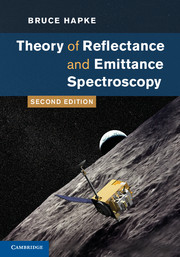Book contents
- Frontmatter
- Contents
- Acknowledgments
- 1 Introduction
- 2 Electromagnetic wave propagation
- 3 The absorption of light
- 4 Specular reflection
- 5 Single-particle scattering: perfect spheres
- 6 Single-particle scattering: irregular particles
- 7 Propagation in a nonuniform medium: the equation of radiative transfer
- 8 The bidirectional reflectance of a semi-infinite medium
- 9 The opposition effect
- 10 A miscellany of bidirectional reflectances and related quantities
- 11 Integrated reflectances and planetary photometry
- 12 Photometric effects of large-scale roughness
- 13 Polarization of light scattered by a particulate medium
- 14 Reflectance spectroscopy
- 15 Thermal emission and emittance spectroscopy
- 16 Simultaneous transport of energy by radiation and thermal conduction
- Appendix A A brief review of vector calculus
- Appendix B Functions of a complex variable
- Appendix C The wave equation in spherical coordinates
- Appendix D Fraunhofer diffraction by a circular hole
- Appendix E Table of symbols
- Bibliography
- Index
11 - Integrated reflectances and planetary photometry
Published online by Cambridge University Press: 05 January 2012
- Frontmatter
- Contents
- Acknowledgments
- 1 Introduction
- 2 Electromagnetic wave propagation
- 3 The absorption of light
- 4 Specular reflection
- 5 Single-particle scattering: perfect spheres
- 6 Single-particle scattering: irregular particles
- 7 Propagation in a nonuniform medium: the equation of radiative transfer
- 8 The bidirectional reflectance of a semi-infinite medium
- 9 The opposition effect
- 10 A miscellany of bidirectional reflectances and related quantities
- 11 Integrated reflectances and planetary photometry
- 12 Photometric effects of large-scale roughness
- 13 Polarization of light scattered by a particulate medium
- 14 Reflectance spectroscopy
- 15 Thermal emission and emittance spectroscopy
- 16 Simultaneous transport of energy by radiation and thermal conduction
- Appendix A A brief review of vector calculus
- Appendix B Functions of a complex variable
- Appendix C The wave equation in spherical coordinates
- Appendix D Fraunhofer diffraction by a circular hole
- Appendix E Table of symbols
- Bibliography
- Index
Summary
Introduction
The basic expression for the bidirectional reflectance of a semi-infinite medium of isotropically scattering particles was derived in Chapter 8 and is given by equation (8.48). This expression was further refined to include an approximate correction for anisotropic scatterers (8.60) and considerations of the effects of porosity (8.70) and the opposition effect in Chapter 9 (9.47). Variants in different geometries were discussed in Chapter 10. In this chapter we will derive expressions that involve integration of the bidirectional reflectance over one or both hemispheres. The remote sensing of bodies of the solar system has its own nomenclature because of the special problems of astronomical observation. Expressions for quantities commonly encountered in planetary spectrophotometry will be derived. Only media for which the porosity factor K = 1 will be treated. Approximate expressions when K > 1 may be readily obtained by substituting one of the linear approximations (8.54 or 8.55) for the H function in the integrand.
Integrated reflectances
Biconical reflectances
If the source and detector do not occupy negligibly small solid angles as seen from the surface, appropriate expressions for the reflectances may be found by numerically integrating one of the above equations over the angular distribution of the radiance from the source and the angular distribution of the response of the detector. In general, such reflectances will be biconical. However, because they would be specific to each particular system, it would not be particularly useful to discuss biconical reflectances in detail.
- Type
- Chapter
- Information
- Theory of Reflectance and Emittance Spectroscopy , pp. 287 - 302Publisher: Cambridge University PressPrint publication year: 2012



